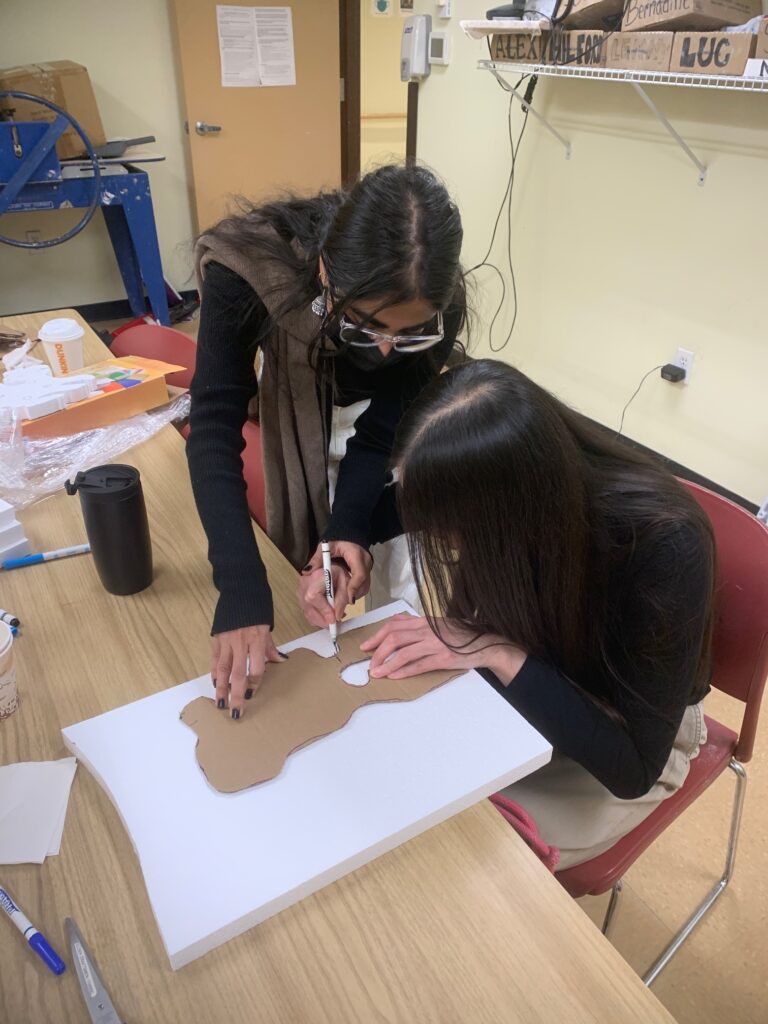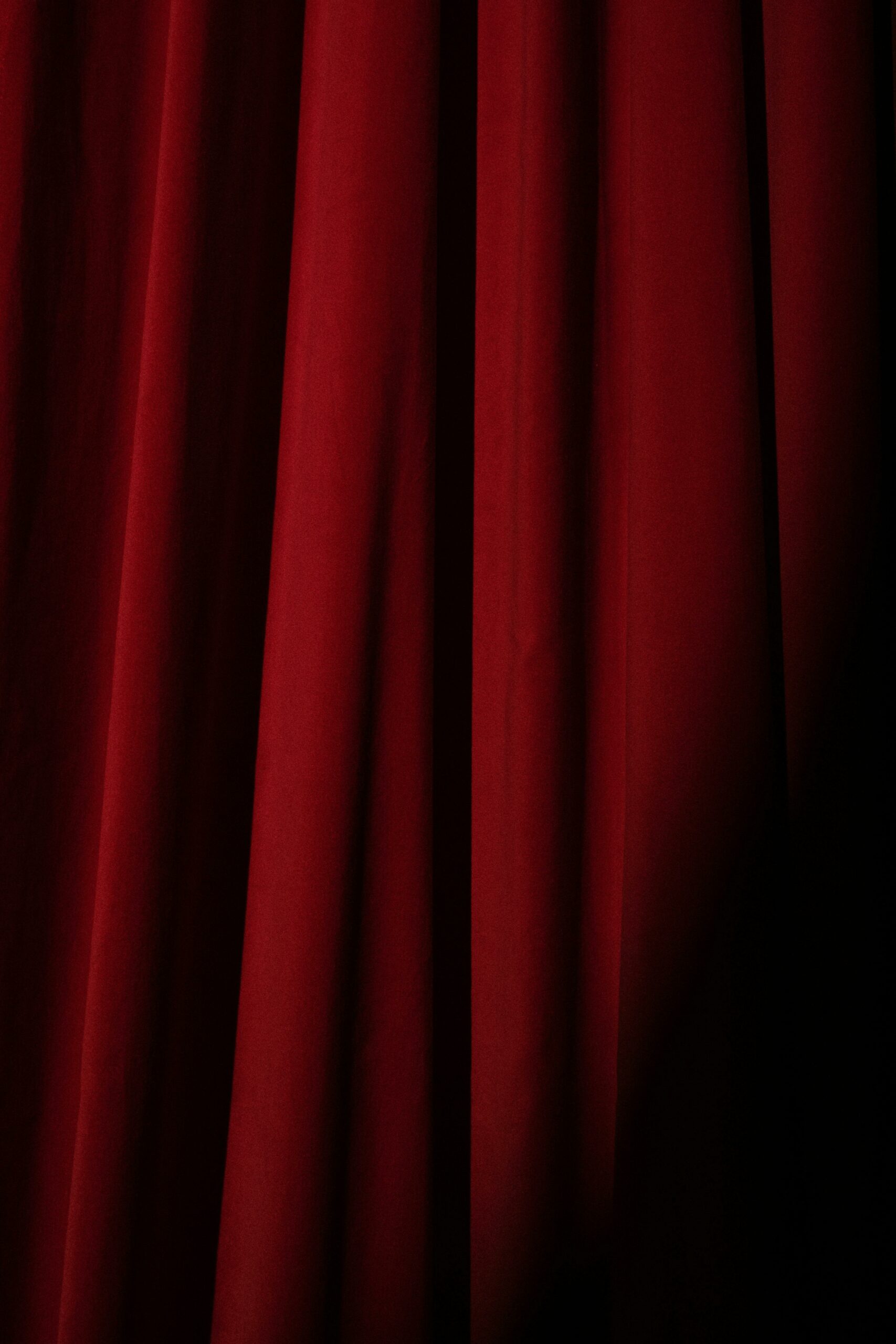Each semester, Teachers & Writers Collaborative (T&W) conducts a semester-long poetry and art workshop at VISIONS, a service organization for blind and visually-impaired folks, led by T&W teaching artists Dave Johnson, Omar Ovalle, and Napoleon Felipe, who have been involved with VISIONS for more than five years. Each semester, the focus of the workshop is something unique and exciting. In the past five years, the participants have delved into documentary, playwriting, abstract art, sculpture, and songwriting, among more.
During one remarkable semester, Spring 2023, participants were introduced to the work of actor, playwright, and professor, Anna Deavere Smith. The participants watched Four American Characters, Smith’s seminal docudrama (a genre of film/TV which features dramatized re-enactments of actual events), in which she plays four interviewees, as well as herself (a solo performance), on a stage to a live audience. Subsequently, participants were asked to write, produce, and perform their own docudramas inspired by Four American Characters, in which they selected their own interview subjects and played their roles on a stage to a live audience, just like Smith. A one-person show. As a 2023-24 Educational Associate at T&W, I assisted Johnson by taking dictation, recording, and assisting the participants with writing and painting.
Poet, playwright, art historian, and social innovator, Dave Johnson is the author of two books of poetry, Dead Heat and Marble Shoot; and two plays, Baptized to the Bone and Sister, Cousin, Aunt. He is the co-translator and dramaturg of two Italian stageplays, the international bestsellers Gomorrah and Super Santos. His visual art curatorial work includes exhibitions at the Queens Museum of Art and at the Milan World Expo. Dave founded and directs Free Verse, a publishing house and working artists’ program born in the New York City Department of Probation waiting room. His awards include fellowships from the Rockefeller Brothers Fund and the Ford Foundation. Dave teaches at The New School and Montclair State University. His present work centers on women artists of the Italian Renaissance.
This interview was conducted over email in April 2024.
Javeria Hasnain (JH): It all starts with listening, says Anna Deavere Smith on her process. The docudrama VISIONS participants produced and performed was inspired by her performance, Four American Characters, in which she plays four “American” characters that she interviewed, including Paulette Jenkins. When I first saw Anna’s performance, I was really overwhelmed. I assume all participants had varied initial reactions. Were they hesitant or enthusiastic?
Dave Johnson (DJ): Absolutely! Careful listening is critical for writers of any form. This group has the sharpest ears and keenest listening skills of any workshop I’ve encountered; we exploit those assets. We often work in forms that ask them to listen intently, render, and respond to what they hear. They took to Anna’s work immediately for its innovativeness and creativity. Also, because participants had never known something like this before.
We often work in forms that ask them to listen intently, render, and respond to what they hear.
JH: Could you explain to us a little bit how the process of creating the performance went and how the participants selected who they will interview? Did you/they encounter any challenges or make any surprising discoveries?
DJ: They enjoyed listening to and discussing Four American Characters by Smith. This was an introduction to the docudrama. In the following weeks, they conducted dynamic and deeply compelling interviews and presented them for the workshop, as a kind of rehearsal for the final play.
At first, they were uncertain who to interview, but we talked them through it. A few of them discovered skills they had no idea they possessed. Many really flourished with talking to people on highly contested issues. They also enjoyed finding folks who offered various opinions. The range of cultural issues they addressed was remarkable: from religion to sex, to childbirth, to first jobs, and the necessity of banks and militaries.
JH: I love that enthusiasm! In my engagement with VISIONS, I have also noticed that active listening is a very fundamental part of the participant’s relationship with each other and the stories they share. How do you, as facilitator, encourage and uphold that, especially because most of our conversations are so informal?
DJ: We discuss work as a shared experience. It’s truly a collaborative effort. We keep it light and also honor each voice. We want to hear from everyone and work to make that happen. It’s a balancing act. This group enjoys each others’ company, and we often work one-on-one with participants during the workshop. Sometimes, this happens with our teaching assistants while the main conversation occurs with the entire class. This group is so flexible that it works. We will often have two art forms in motion at once. They create art with their hands and discuss poetry, too. They will create a story, dialogue, or verse with their original sculptures at their fingertips. They turn on their phone recorders, or we take dictation. We send them what they say by email, and they type their voice notes. The next week, they arrive with a new text to recite to the class. It’s often a sculpted story or the story of sculpture, both of which spark simultaneously.
JH: This semester, we taught “The Material Word,” in which the participants made abstract sculptures from papier-mache. One of my professors explains abstraction as a reaching towards the ineffable. There is something inherently abstract about visually-impaired people creating visual art. How do you think about it when planning your syllabus?
DJ: That’s a good question. And believe me, when I first told some sighted people this is what I wanted to do next, I got some sidelong glances. However, at VISIONS, they visualize everything, and this visualization sometimes starts in the mind but sometimes in the hand, nose, or ear. Sighted folks sometimes limit their vision of the visual by only considering the eye, but for any artist, creating always encompasses so much more. Often, the most compelling work engages the entire body, and let’s not forget the mind and, most importantly, the spirit. We prefer to call our work the Physical Arts, thus, the Material Word (besides, it rhymes with Material Girl, and we have a resident music historian in our group, John Ferrard, who loves Madonna).
Often, the most compelling work engages the entire body, and let’s not forget the mind and, most importantly, the spirit.
JH: So many of the workshops combine writing with other genres. Can you name some of the other genres that you’ve introduced with the participants at VISIONS? How do you decide what direction to take when planning a program?
DJ: One-Act Play. Broadway-Style Musical. Popular Songwriting. Visual Art. Physical Arts. Poetry. Stand-up. Story & Sculpture. Poetry & Music. Mythmaking & Masks.
Often, I peruse what’s on the local calendar at the museums and galleries and what’s on in other communities where I work, like The New School, Cooper Union, Montclair U., NYU Casa Italiana, Brooklyn Public Library, Brooklyn Museum, and Queens Museum. I bring them what’s happening now, and they love going out to witness something new. It’s exciting. We went to the Queens Museum this semester to experience work by a visually impaired artist in residence. We’ve gone to Broadway Musicals and for a touch-tour of Picasso Sculptures at MoMA. European tourists are always jealous and try to join our traveling gallery workshops when they see us interacting with the artwork.

JH: Since participants do something different each semester, for example, create a docudrama performance, write and perform songs, design animal masks, and now, showcase abstract sculptures, how/do your teaching strategies and approaches change or remain the same from semester to semester, depending upon what the final performance will look like?
DJ: The goal for the final performance is always the same: to honor the artists and their work and present it with the same passion they bring to the workshops. To achieve this, we focus squarely on their original work and assist them in making it to the highest level possible. This is an incredible group. They deserve all the credit. They are dedicated. We are also blessed with teaching artists and visiting artists who care deeply about the work and the participants. Truthfully, one day at Visions, and you’re hooked. The energy is palpable, and the spirit is generous.
JH: I agree! It has been more than six years since you started teaching at VISIONS. How do you keep the spark alive with the participants?
DJ: We keep it fresh by offering different workshops with different titles and slightly different angles. We do multidisciplinary work but always remember what they enjoy most and keep some of those elements rolling every time. Parties. Food. Field Trips. We always check the calendar and ensure we know what else is happening at the center and in our participants’ lives. An example is Valentine’s Day this semester. Our workshop coincided with a big celebration at the center. So we moved our workshop in the middle of the festivities, showcased our work to other seniors, and performed on the open mic. We turned our workshop that day into an opportunity for the wider community to experience what we do. Several newcomers visited our table and created new poems and artworks for the first time.
JH: Have any of your students had breakthroughs of any kind, either creatively or in other areas of their lives as a result of the program?
DJ: You might consider asking some of the participants. One of the participants, Fritz, particularly enjoyed the docudrama writing and went above and beyond. He started with interviewing his mother about his own birth, then asked some acquaintances and friends about their opinions on organized religion and its role in modern society. Finally, he interviewed seven of his fraternity brothers he went to college with. In his own words, “this opened a door for me to create in a way I had never imagined.”
A few years back, a female couple came out to the workshop and eventually to the entire center. They had been a couple but were uncertain they would be accepted. It all happened for the first time in our workshop. It was beautiful. As a result, one of the ladies wrote her first play ever, which featured gay women detectives, their cases, and their social lives. It was truly amazing.
JH: That is indeed beautiful. It has been the experience of a lifetime working at VISIONS with you, Omar, and Napoleon. Thank you.
VISIONS: Services for the Blind and Visually Impaired is a nonprofit rehabilitation and social service organization whose purpose is to develop and implement programs to assist people of all ages who are blind or visually impaired to lead independent and active lives in their homes and communities; and to educate the public to understand the capabilities and needs of people who are blind or visually impaired so that they may be integrated into all aspects of community life.
Read more from VISIONS in the magazine:
– “Where I’m From: The Musical” by Dave Johnson
– “VISIONS: An Anthology of Poetry from Selis Manor’s Senior Center” by Dave Johnson
– “Playwriting at VISIONS: Six Writing Lessons for Playwriting” by Dave Johnson
– “Songwriting at VISIONS: Lesson Plans that Introduce Older Adults to the Fundamentals of Songwriting” by Dave Johnson
– “Writing Micro-Memoirs at Visions: A Writing Workshop for the Blind and Visually Impaired” by Victoria Richards
Featured photo by cottonbro studio.

Javeria Hasnain
Javeria Hasnain is the author of SIN, a poetry chapbook forthcoming in 2024. Her works have appeared in numerous journals, includingPleiades, Poet Lore, The Margins, Mascara Literary Review,and elsewhere. She is an MFA Poetry candidate and a Fulbright scholar at The New School.



